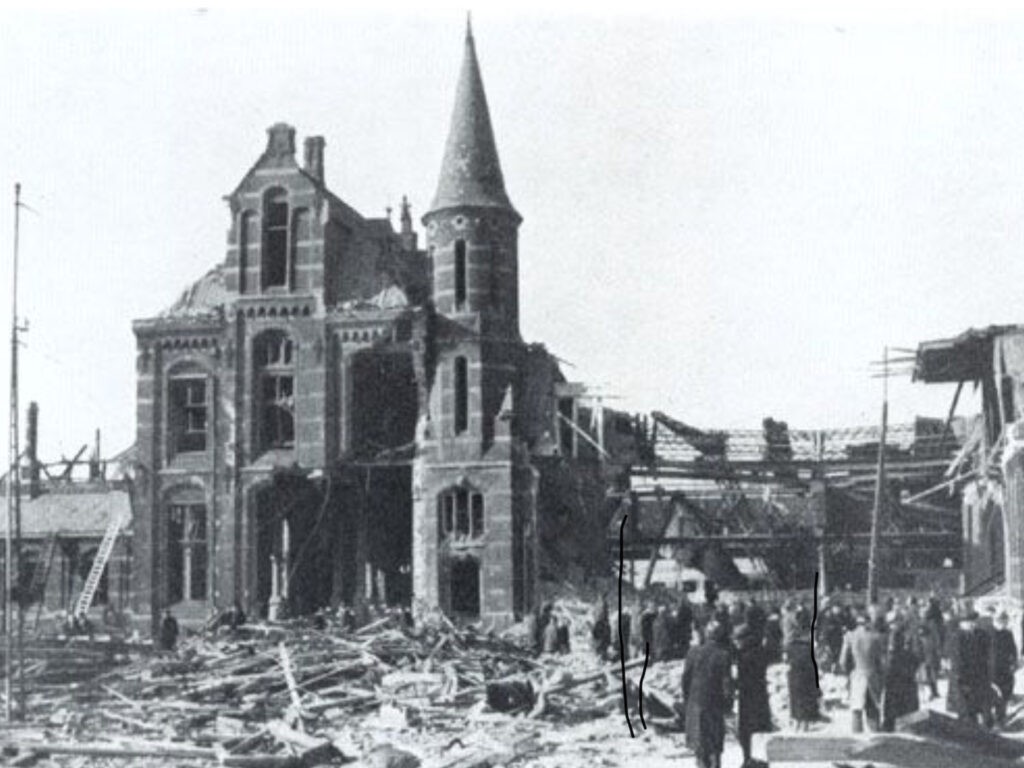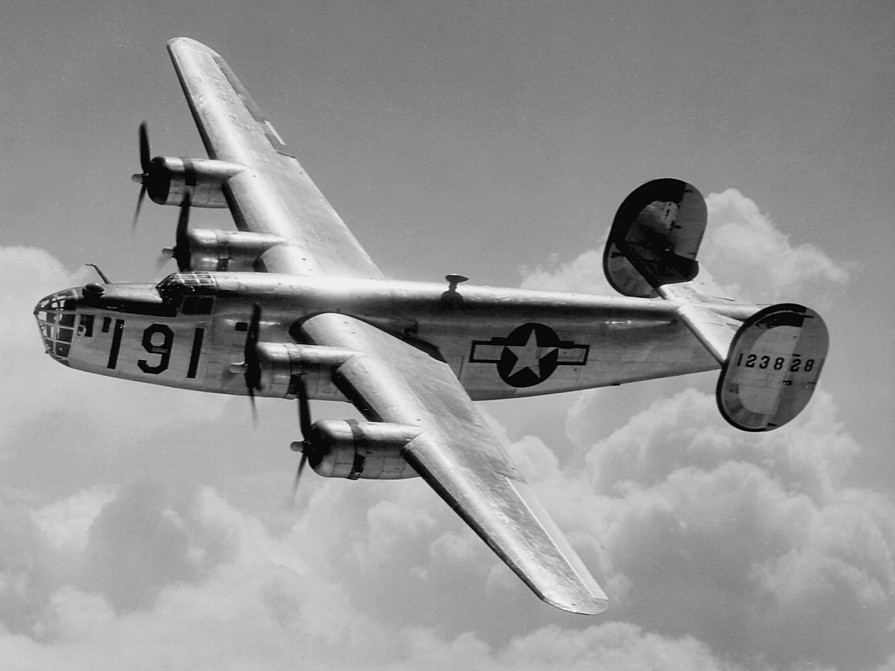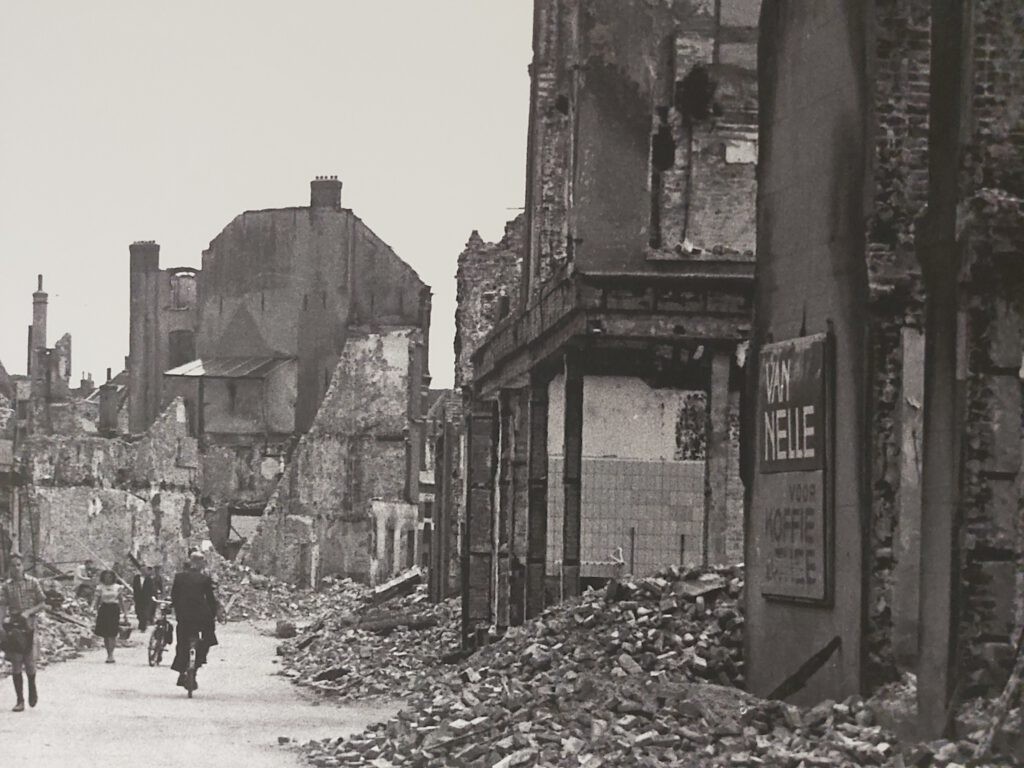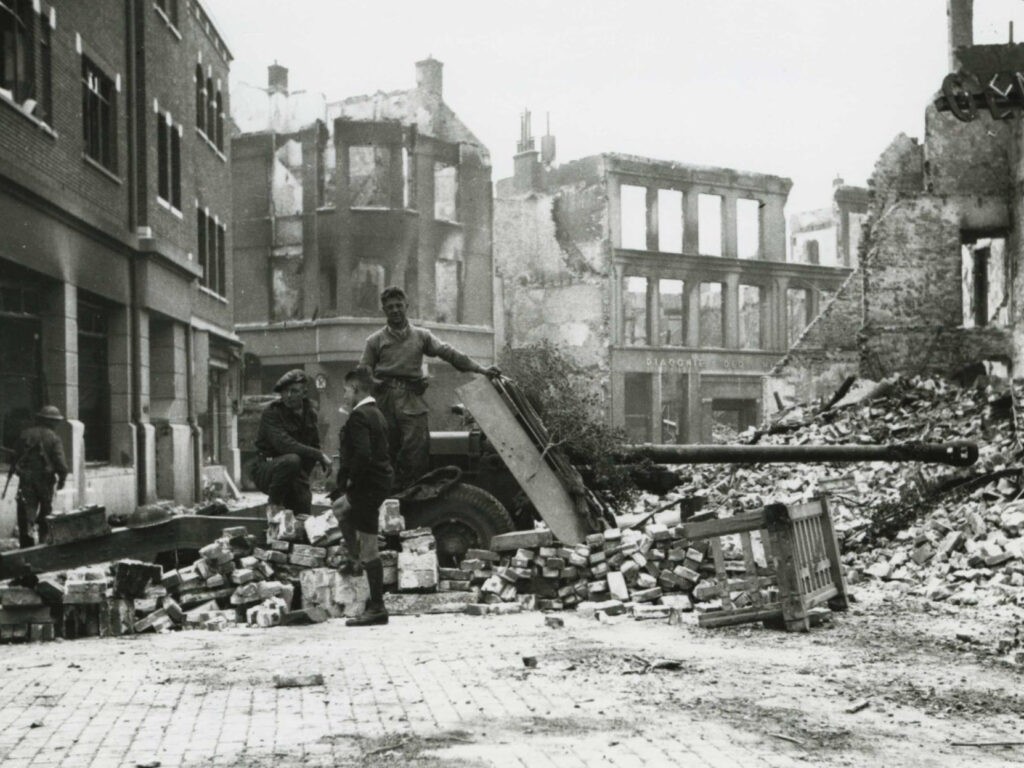In the previous article about the B-17, I already referred to the bombing of Nijmegen on February 22, 1944. Several Dutch cities were bombed multiple times during WWII. Rotterdam, initially razed to the ground by the Germans, was also bombed by Allied air raids on the port area. The Hague was attacked with a precision strike on the Bezuidenhout district to destroy German rocket installations. Unfortunately, the target was missed, and the residential areas were leveled. During the Battle of the Scheldt and the reclamation of the Scheldt banks, Breskens and Westkapelle were largely destroyed, and Amsterdam-Noord was attacked to destroy the Fokker factories. There is a long list of other Allied air raids, more or less successful, but always with many civilian casualties and damage to buildings. But one day stands out: February 22, 1944. That day would have a major impact on Nijmegen, Enschede, Arnhem, and Deventer.

Before delving into this dark day in history, let’s first take a moment to recap. Most bombs were dropped in the final years of the war, a total of 2.7 million, of which 1.5 million fell on Germany, 650,000 in 1944, and 500,000 in the first months of 1945. Note that these were strategic bombings, not attacks in support of ground forces. The Allied tactics were essentially the same as those of the Germans. Initially, the focus was on bombing factories and airfields, but later the tactic shifted to eliminating as many workers as possible, the weakest link in the production process. Thus, in England, London, Manchester, Liverpool, Coventry, Plymouth, and Southampton were bombed. On September 7, 1940, 372 bombers and 642 fighter planes severely damaged the port of London. In Germany, virtually every major city with a significant war industry was bombed. These bombings resulted in a massive number of civilian casualties: Hamburg suffered 49,000 deaths, Berlin 35,000, and Dresden, in a single bombing raid in February 1944, an estimated 25,000. The total number of deaths from bombing in Germany is estimated at 410,000, hundreds of thousands wounded, and millions of refugees.
As if it were a business deal, the Allies also drew up a budget. This budget included 900,000 dead, a million wounded, and 25 million people driven from their homes. The figures alone suggest that the bombings did not achieve the expected success. The reason was the method of attack. After the war, Albert Speer called the Allied tactics “not systematic.” He cited the bombing of Schweinfurt, where most of the ball bearings for the war industry were manufactured, as an example. Schweinfurt was bombed several times, but not very successfully, and the damage remained limited. According to Speer, if the Allies had continued to bomb Schweinfurt systematically, the German war industry would have been brought to its knees sooner, simply due to the lack of ball bearings.
For both the British and the Germans, the population’s morale wasn’t broken. Especially after Hitler’s promise that “not a single German city would be hit by bombs,” Hitler and his cronies were certainly afraid of this. The bombings became a daily part of life. With a touch of British humor, the British called a day with heavy bombing a “very blizzy day”. However, the destruction of culturally valuable buildings had an enormous impact. The bombings of England were carried out under the command of Hitler and Hermann Göring. The Allies initially had a separate American unit led by Carl Spaatz for precision bombing, but later they got along well with Arthur Harris, a proponent of strategic bombing. For the first time, they collaborated on a bombing raid on Hamburg. This resulted in a carpet bombing in July-August 1943, using explosive and incendiary bombs. A veritable firestorm was the result.
The bombing of Nijmegen, February 22, 1944.
The targets of the bombing raid on 22 February 1944 were Oschersleben, Aschersleben and Gotha, part of Operation Argument .
Formation problems

The biggest problem for the Americans was getting the hundreds of bombers into formation quickly. Radio wasn’t allowed; instead, they used radio beacons, the goal being to reach flight altitude and formation without seeing or hearing each other. Each pilot meticulously crawled his aircraft to the formation altitude following a specific pattern. A plane took off every 30 seconds, but in poor visibility, this was limited to one per minute. Forming a single group, consisting of 36 aircraft, took over an hour, and that was only a small part of the total group. With a group of three or more aircraft, the last beacon was located and divisional formation was formed. If any aircraft in the group had an equipment problem or an engine wasn’t delivering the required power, it was chased by a colleague with no problems, resulting in near-collisions or crashes.
One of the first to notice something unusual was about to happen on February 22nd was Michael Fraser, owner of a small farm near the airport runway. Fraser had woken up earlier than usual due to the activity around the airport. However, the clouds were so low you couldn’t see a thing. Normally, flying wasn’t done in this weather. He looked in the direction of the airport and decided to wait until the planes had taken off. However, he heard more than he saw, as the heavy aircraft rumbled over his head less than 100 meters above.
Chaos
Formation leader Schmidt’s day also didn’t start well. He had an ominous feeling. The heavy, hanging clouds, interspersed with snowstorms, seemed to fuel this feeling. Nevertheless, he set off and began the complicated task of forming up. Schmidt was part of the 446BG (bombardment group) and assembled at 3,000 meters, with an unarmed B-24 painted with white, brown, and yellow stripes as a visible beacon. On this day, with very poor visibility, the B-24 fired a yellow flare every two minutes. After completing the formation, this aircraft returned to base. Once all aircraft were more or less in formation, a course was set for the final targets. Soon, the Dutch coast was reached, and all the clouds suddenly disappeared. Schmidt sent a short message stating that he would continue flying until 10 miles beyond the coast and then make a decision on whether to proceed.
At 12:25 p.m., however, the radio came on, with the order to abort the operation. Schmidt was baffled, as the weather conditions were practically perfect. Schmidt wanted to be certain and ordered the deputy leader, Lieutenant Martin, to confirm the message. A short time later, Schmidt received confirmation from Martin that such a message had indeed been transmitted and confirmation had been received. Schmidt then ordered the mission to be aborted and to search for a target of opportunity . By that point, the formation had already penetrated 70 kilometers into Germany, near Borken. The problem, however, was that groups other than 446BG, for various reasons, had not received this message or had received it only partially. Some groups continued flying, while others turned left and right on their way home. This was the beginning of the chaos that ultimately led to the bombings of Nijmegen, Enschede, Arnhem, and Deventer.
Deventer
Chaos broke out around Deventer. The 93rd Air Force aircraft flew in a crisscross pattern. This suggests that the bombs dropped in the meadows near Deventer were emergency drops. If Deventer had indeed been an alternative target, the bombs would have hit the city of Deventer or the bridge over the IJssel River. The damage was minimal, just a few bomb craters in the meadows surrounding Deventer.
Enschede
Flying over Haaksbergen, the 448th Airborne Division spotted a town in the distance that they identified as Münster. They assumed Haaksbergen must therefore be Dülmen. From above, there is indeed a striking similarity in location between the towns of Dülmen and Münster, and Haaksbergen and Enschede. Residents of Enschede saw the Allied aircraft approaching and stood in awe. That admiration ended when a yellow-orange flare was dropped from the first aircraft, followed by a hail of cluster and high explosive bombs, which caused an immense inferno. It’s arguable that the attack on Enschede was a mistake after all. After all, the border between Germany and the Netherlands is invisible from above, and the confusion of the four towns likely led to this disaster.
Arnhem

By now, the 446th Airborne Division, led by Schmidt, had no idea where they were exactly. In the distance, they saw a town they identified as Bocholt. When they tried to launch their attack, they were obstructed by another formation crossing their path. An unavoidable evasive maneuver was initiated, which landed them over Lochem, Almelo, and then Enschede. They were severely hampered by a gale-force wind at their altitude, causing the entire group to drift westward. However, Schmidt was still convinced they were now back over Germany. He saw a fairly large town on a river in the distance. He prepared for another attack run. At the crucial moment, they were again obstructed by another group of bombers, and Schmidt decided to alter course again, ultimately heading home.
When Schmidt was almost on course, he spotted another town, also on a river. It seemed like an ideal target, so Schmidt ordered an attack. Due to a lack of time, it became a hasty, sloppy operation, with many bombardiers having no idea where they actually were. Nevertheless, they all dropped their payloads of high explosives. Most of the bombs hit the chosen target, in and near Arnhem. The damage caused by the bombing was mitigated by the fact that many bombs landed in the Rhine and the Rhine embankment. Part of the Rhine Dike gasworks and a section of industrial estate were destroyed.
Report by Arthur Livingston, air gunner:

Livingston overheard the conversation between the pilot and co-pilot about the attack on Bocholt. The bombardier at the very front of the aircraft interrupted the conversation, announcing that the attack run would have to be made through another formation. The pilot announced that he had seen it too and was going to make a sharp turn to the right. Livingston was irritated by the perilous search for some target, instead of heading straight home. During a subsequent attack attempt, they were again hampered by crisscrossing bombers attacking Teuge airfield. Another sharp turn was initiated, and Livingston now truly hoped they were heading home. However, the pilot said over the intercom, “Prepare for attack.” The bomb bays opened, but suddenly the voice of navigator Lloyd Hart came through clearly, remarking, “That’s strange, we’re over Holland.” No one reacted, and Livingston watched the bombs impact a densely populated area of factories and houses. A slight swerve and the bomber headed home. Hart was almost certain they’d dropped their bombs on Arnhem, but, he added a moment later, “It could also have been Nijmegen. I’m not certain.”
Nijmegen

Meanwhile, the remainder of the 446th Air Force, led by Henderson, diverted and spotted another fairly large town with two bridges and a marshalling yard. They still didn’t realize they were over Holland, and orders were given to attack this new target, which they only learned later was Nijmegen. At a range of 4 kilometers, the 1200-pounder bombs roared out of the aircraft. The aircraft alongside and behind the leader followed in the attack and also dropped their bombs. Two Liberators of the 453rd Air Force, which had joined the 446th Air Force, carried a different kind of bombs. Forty clusters of six small bombs burst upon impact, spreading a shower of deadly steel splinters. One aircraft dropped all 40 on the station. Seven clusters of the other 453rd Air Force remained in the bomb rack, a blessing in disguise for Nijmegen. Two clusters later landed on Tibenham airfield in England, killing several ground crew members. Henderson’s formation dropped a total of 144 500-pound high explosive bombs and 426 20-pound shrapnel bombs. The bombing, primarily due to the shrapnel bombs, caused a large number of deaths and injuries.
When the Allied bombers first flew over on their way to Germany, the air raid siren sounded in time, allowing everyone to get to their shelters. The “all clear” signal had just been given when the bombers returned. People had just started to go outside when the bombs began to fall.
There is no doubt about this bombing, partly due to the photographs taken. However, many eyewitnesses also reported low-flying aircraft. No evidence has ever been found regarding the nationality and origin of these aircraft. A plausible explanation is that a formation of B-26 Marauders and A-20 Havocs from the 2nd Tactical Air Force was searching for a target during a sweep over the mainland. They attacked everything they encountered, flying low and at relatively high speed, that was worth bombing. It’s not inconceivable that they followed the high-flying Henderson aircraft, assuming they too were attacking a German target because their larger counterparts were doing so. Whether and what was dropped by these aircraft will always remain a mystery. A second possibility is that German aircraft were conducting an exercise over Nijmegen. The massive bombing virtually razed Nijmegen to the ground.
From the above accounts, one might conclude that the attacks on Deventer, Enschede, Arnhem, and Nijmegen were a costly mistake, unlike bombings whose targets had been predetermined. Deventer was deliberately bombed by the Allies on October 28, 1944, with the bridge over the IJssel River as the target. However, houses in the surrounding area were also hit. 46 civilians were killed. Enschede had already been bombed once before, on October 10, 1943, targeting Teuge airfield. This resulted in 151 deaths, 104 serious injuries, and extensive damage to the city.
To halt the buildup of German troops, an attempt was made on October 6 and 7, 1944, to destroy the Rhine Bridge, which had been the subject of such fierce fighting during Market Garden, by bombing. However, most of the bombs landed not on the bridge itself, but on Arnhem’s city center. Although the bridge was damaged on October 6, it was still usable by the Germans. A new attempt was made on October 7. Again, most of the bombs landed on the city center. However, several direct hits shattered the bridge, partly due to the detonation of explosives planted by the Germans.
Sources: The fatal attack – AE Brinkhuis
Various Wikipedia and Historianet articles